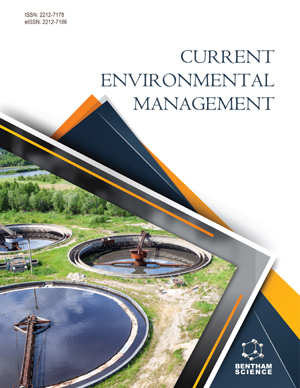Abstract
Background: Purification and remediation of water remain to be a mammoth challenge for environmental engineers, continuously mounting pressure on providing safe water for consumers. Nevertheless, care has to be taken to avoid chemicals in treatment, which could prove to be toxic. One of the most prominent stages in treating water for human consumption is clarification through coagulation and flocculation to remove colloidal particles including silt, clay, precipitated iron or manganese oxides along with bacteria and algae.
Objective: In order to achieve sustainability, the only possible way is to use innate materials in combination with inherent technologies. Considering this, the present review will appraise the efficiency of natural coagulants in treating surface water. Several researchers have tested numerous natural coagulants for clarification of water. Nevertheless, information on various natural coagulants and their efficiency has not yet been presented.
Methods: Hence, an attempt is made to bring about a comprehensive account of various natural coagulants and also to understand their properties and efficiencies in treating water.
Results: Cumulative information regarding natural coagulants presented in this review will add to the database of natural coagulants and can be adopted at various temporal and spatial levels according to the availability of these coagulants to treat water. Nevertheless, precise research on coagulation parameters and shelf life of treated water will enhance the opportunities for point of use water treatment technologies.
Conclusion: The current review presents natural coagulants having the potential to treat surface water as sustainable alternatives to point of use treatment.
Keywords: Natural coagulants, sustainability, water treatment, turbidity, coagulation, flocculation.
Graphical Abstract
[http://dx.doi.org/10.1016/j.cej.2010.07.011]
[http://dx.doi.org/10.1016/S0305-750X(00)00071-1]
[http://dx.doi.org/10.1002/wat2.1043]
[http://dx.doi.org/10.1590/S1413-41522008000300001]
[http://dx.doi.org/10.1007/0044-7447-33.sp13.29] [PMID: 15575180]
[http://dx.doi.org/10.1016/S0016-7185(97)00017-1]
[http://dx.doi.org/10.1002/sd.346]
[http://dx.doi.org/10.9734/CSJI/2017/34041]
[http://dx.doi.org/10.5004/dwt.2018.23228]
[http://dx.doi.org/10.1016/j.pce.2009.07.001]
[http://dx.doi.org/10.1002/2014WR016869]
[http://dx.doi.org/10.1007/s13201-015-0372-1]
[http://dx.doi.org/10.1016/j.jwpe.2019.100982]
[http://dx.doi.org/10.4314/jasem.v17i2.8]
[http://dx.doi.org/10.1016/j.jenvman.2012.07.023] [PMID: 22922457]
[http://dx.doi.org/10.2166/wst.2004.0705] [PMID: 15686013]
[http://dx.doi.org/10.1007/BF02697288]
[http://dx.doi.org/10.2166/wst.1993.0261]
[http://dx.doi.org/10.1016/j.watres.2012.04.043] [PMID: 22627114]
[http://dx.doi.org/10.1002/j.1551-8833.1988.tb03022.x]
[http://dx.doi.org/10.1146/annurev.pp.31.060180.002423]
[http://dx.doi.org/10.1007/s11356-015-5282-0] [PMID: 26315593]
[http://dx.doi.org/10.1007/s00244-009-9435-3] [PMID: 20012432]
[http://dx.doi.org/10.2166/ws.2007.147]
[http://dx.doi.org/10.1016/j.biortech.2017.03.119] [PMID: 28366689]
[http://dx.doi.org/10.1021/cr400093w] [PMID: 24495201]
[http://dx.doi.org/10.1016/j.procbio.2010.05.030]
[http://dx.doi.org/10.1016/j.chemosphere.2016.10.054] [PMID: 27788365]
[http://dx.doi.org/10.1016/j.biortech.2009.06.047] [PMID: 19604691]
[http://dx.doi.org/10.1016/S0032-9592(99)00085-0]
[http://dx.doi.org/10.1080/15422119.2011.542737]
[http://dx.doi.org/10.1080/10934520600657156] [PMID: 16854810]
[http://dx.doi.org/10.1016/j.chemosphere.2006.01.038] [PMID: 16504239]
[http://dx.doi.org/10.1080/00207230210924]
[http://dx.doi.org/10.1021/jp808453z]
[http://dx.doi.org/10.1007/s12205-013-2021-2]
[http://dx.doi.org/10.1007/s13201-019-1108-4]
[http://dx.doi.org/10.1016/j.biortech.2005.07.031] [PMID: 16213137]
[http://dx.doi.org/10.1016/0043-1354(94)00161-Y]
[http://dx.doi.org/10.1016/j.ijbiomac.2010.10.004] [PMID: 20951725]
[http://dx.doi.org/10.1002/app.28399]
[http://dx.doi.org/10.1016/0008-6215(94)00149-9] [PMID: 7982225]
[http://dx.doi.org/10.1016/j.jtice.2016.07.009]
[http://dx.doi.org/10.1016/j.procbio.2005.08.016]
[http://dx.doi.org/10.1016/j.jes.2014.09.024] [PMID: 25458671]
[http://dx.doi.org/10.1007/s13762-013-0446-2]
[http://dx.doi.org/10.2174/221271780301160527201624]
[http://dx.doi.org/10.1016/j.indcrop.2015.01.045]
[http://dx.doi.org/10.1016/j.wasman.2014.11.025] [PMID: 25655353]
[http://dx.doi.org/10.5004/dwt.2011.1493]
[http://dx.doi.org/10.1080/09593331708616479]
[http://dx.doi.org/10.1111/j.1478-4408.2002.tb00109.x]
[http://dx.doi.org/10.1016/S0043-1354(97)00295-9]
[http://dx.doi.org/10.1080/09593331908616735]
[http://dx.doi.org/10.5402/2011/632189] [PMID: 23724307]
[http://dx.doi.org/10.2166/ws.2006.027]
[http://dx.doi.org/10.1016/j.indcrop.2015.06.027]
[http://dx.doi.org/10.1016/j.eurpolymj.2008.12.027]
[http://dx.doi.org/10.1016/j.watres.2012.06.021] [PMID: 22770964]
[http://dx.doi.org/10.1007/978-981-10-5708-3_22]
[http://dx.doi.org/10.1016/S0006-3495(04)74197-1] [PMID: 14747357]
[http://dx.doi.org/10.1021/bc800428y] [PMID: 19152330]
[http://dx.doi.org/10.11648/j.ajche.20180602.12]
[http://dx.doi.org/10.1016/j.jwpe.2015.04.004]
[http://dx.doi.org/10.1016/j.colsurfb.2014.01.008] [PMID: 24503349]
[http://dx.doi.org/10.1007/s00128-006-1065-0] [PMID: 16977535]
[http://dx.doi.org/10.1007/s10661-014-3775-9] [PMID: 24788840]
[http://dx.doi.org/10.1016/j.biortech.2010.06.020] [PMID: 20591652]
[http://dx.doi.org/10.1016/j.procbio.2005.08.006]
[http://dx.doi.org/10.1002/csr.191]
[http://dx.doi.org/10.1016/S0144-8617(99)00183-6]
[http://dx.doi.org/10.1016/0014-5793(73)80770-7]
[http://dx.doi.org/10.1016/j.desal.2012.05.004]
[http://dx.doi.org/10.1007/s11356-016-6768-0] [PMID: 27164875]
[http://dx.doi.org/10.1007/s13201-019-1009-6]
[http://dx.doi.org/10.3362/0262-8104.1990.020]
[http://dx.doi.org/10.2166/ws.2002.0155]
[http://dx.doi.org/10.1088/1755-1315/16/1/012065]
[http://dx.doi.org/10.1007/s00217-008-0892-0]
[http://dx.doi.org/10.4236/nr.2012.32006]
[http://dx.doi.org/10.1016/j.jhazmat.2010.03.053] [PMID: 20378245]
[http://dx.doi.org/10.1016/j.jhazmat.2008.09.096] [PMID: 19081180]
[http://dx.doi.org/10.1515/revce-2014-0041]
[http://dx.doi.org/10.1088/1742-6596/1349/1/012011]
[http://dx.doi.org/10.1021/es7025054] [PMID: 18605544]
[http://dx.doi.org/10.1016/j.chemosphere.2009.08.036] [PMID: 19786292]
[http://dx.doi.org/10.12989/aer.2013.2.3.229]
 4
4


